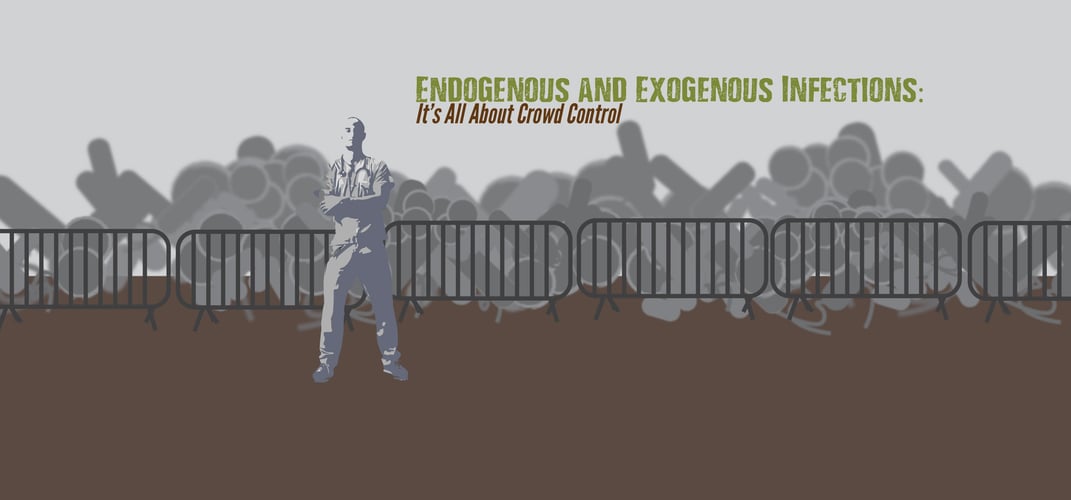Editor's Note: This post was originally published in January 2015 and has been updated for freshness, accuracy and comprehensiveness.
Stealthy Passengers: E. coli, Klebsiella, and Enterococcus

Today's trio of pathogens are stealthy, living on our bodies without causing us harm but wreaking havoc when they find a way inside a bacteria-free, or sterile part of our body (lungs, bloodstream, internal organs, and others). Typically they are surrounded by other species of bacteria in our intestines or on our skin, using all their energy to battle it out for resources with the other species of bacteria that surround them. This keeps them in check. However, if they are able to enter the sterile parts of our body through an incision or medical device, they find themselves in a new territory with absolutely no competition. With uncontested resources, they quickly reproduce and create an infection which can cause great harm, and even death.
Escherichia coli | 16% of HAIs
We know this two-faced bacteria as e. coli. Most of the time, this bacteria lives happily in our gut, helping us break down our food and releasing the nutrients we need to survive. They even help us control pathogenic bacteria from colonizing in our intestines. But since e. coli lives along our digestive system, it travels with our digested food and also exits along with our waste. If that waste is not handled appropriately, or hygiene is not maintained, or surfaces not thoroughly cleaned, that e. coli is let loose into the outside world without competition, where it can wreak havoc. E. coli is the number one cause of catheter-associated urinary tract infections, as well as gastroenteritis, septicemia, pneumonia, and numerous other infectious diseases (as well as food borne illnesses).
Klebsiella | 8% of HAIs
This is another example of a bacteria that becomes pathogenic and opportunistic once it leaves the competitive environment of our gut or skin. There are two strains that are particularly prevalent: Pneumaniae causes most hospital-acquired respiratory tract infections and pose a great threat to premature infants in ICUs; oxytoca causes sepsis and colitis, both infections resulting in dangerous inflammation. Klebsiella can survive on many hospital surfaces for an extended period of time, and has become more drug-resistant over time.
Enterococcus species | 7.4% of HAIs
Formerly thought to be a part of the Streptococcus family, Enterococcus are found in most of our intestines and guts. The faecalis species, found in 90-95% of us, is a normal bacteria that becomes nasty when it escapes. It is highly adaptive, can survive for long periods of time with no nutrition, and is extremely drug-resistant in hospital settings. In fact, they have a built-in resistance to the most common antibiotics (penicillin, cephalosporins, and carbapenems) and have demonstrated a growing resistance (especially the faecium species) to one of the remaining antibiotic classes (vancomycin), leaving only a few, costly, and not 100% effective, options. This group of bacteria is one the leading causes of central line-associated infections, and is known to be almost impossible to eradicate until the medical device (access to the body) is removed.
This terrifying trio demonstrates the delicate balance between our bacterial flora (living bacteria that co-exist with us, on and in our bodies) and our bodies. Vulnerable patients require that the surrounding bioburden (the amount of bacteria present in the environment) be drastically reduced in order to prevent infection. This reduction is achieved through a multi-pronged approach: Hand hygiene (patient, visitors, healthcare workers), environmental services (room cleaning), and preventive biocidal materials which kill bacteria continuously. It's an ongoing battle, but technological advances are making a difference.
Our next post in this series will deal with two hard-core bacteria with adaptive superpowers as well as the one fungus joining our notorious gang, the loner who waits until bacteria around it start to die off from antibiotics before attacking with a vengeance.
For more information about this week's pathogens, their prevalence, and their persistence, click on the link below!
![EOScu Logo - Dark - Outlined [07182023]-01](https://blog.eoscu.com/hubfs/Eoscu_June2024/Images/EOScu%20Logo%20-%20Dark%20-%20Outlined%20%5B07182023%5D-01.svg)

![[infographic] Pathogens, Prevalence and Persistence Download and share!](https://no-cache.hubspot.com/cta/default/216314/interactive-178382222670.png)



